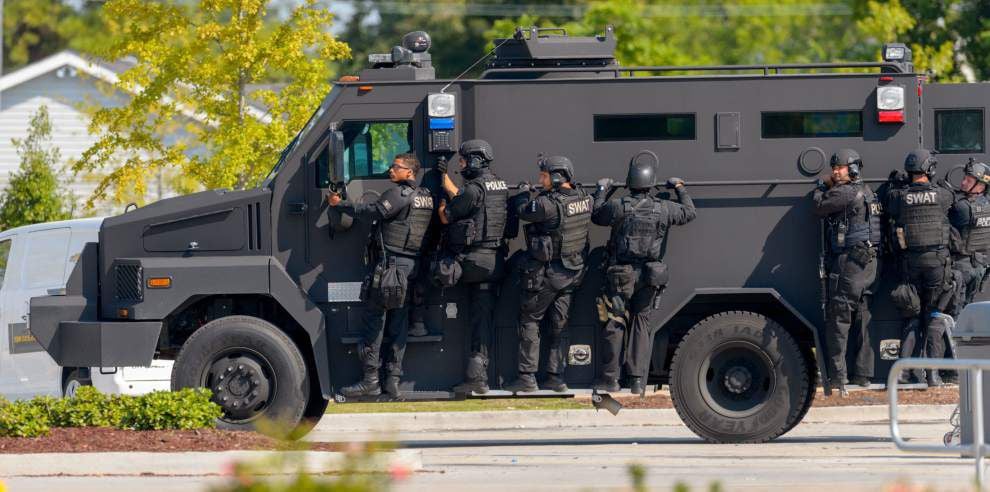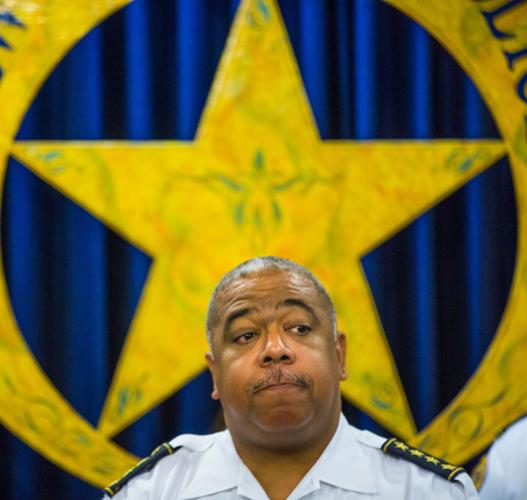New Orleans is on pace to record a staggering drop in gun violence in 2018, with homicides set to fall to the lowest level in decades and shootings down 30 percent, offering at least a momentary victory for city officials in their fight against the city's most unrelenting public-policy crisis.
If current trends hold through Dec. 31, this year will see 144 homicides in New Orleans, the lowest number since 1971, although the per capita homicide rate remains very high.

Armed robberies are down as well, falling 12 percent so far this year.
“We’ve still got a bit to go … (but) we’re optimistic,” Police Department Superintendent Michael Harrison said in an interview. “We’re grateful.”
The sudden drop in violence from last year means that the progress could be more of a statistical anomaly than a sustainable trend. But it nevertheless represents a noteworthy talking point for Mayor LaToya Cantrell’s administration, and particularly Harrison, who has been trying to bring down violent crime since his appointment as chief in 2014.
With a little more than two weeks left in the year, Harrison outlined steps his agency took that he said are responsible, in part, for the declines.
Among the most important, he said, is the increased use of crime cameras that began under the administration of Mayor Mitch Landrieu, as well as the maturing of a two-year-old tactical team focused on arresting repeat violent offenders.
The Tactical Intelligence Gathering and Enforcement Response — or TIGER — team initially assigned its officers to tackle serial armed robbery and carjacking cases for as long as it took to solve them.
Since its creation, the city recorded year-over-year drops in armed robberies in 2016 and 2017. The 589 armed stick-ups reported in 2018 as of Thursday were a 12 percent drop from a year earlier, bringing within reach a third consecutive dip in the number of such robberies.
The lucky 13th episode of the New Orleans Advocate's weekly podcast, "The Neutral Ground," is available for download.
Harrison said TIGER has since applied its approach to shootings, with a focus on people who are suspected of repeat offenses.
The chief was reluctant to discuss any specific cases where the unit succeeded, with some unresolved and awaiting prosecution.
But one case that appeared to fit the bill was that of Robert Lavigne, who had been paroled after admitting a role in a 2012 killing, when a homicide investigation that involved TIGER led to his being charged in a Sept. 4 slaying in Gert Town.
Role of crime cameras
Meanwhile, Harrison said, a tool that the NOPD has come to use in numerous criminal investigations is the growing network of street-facing surveillance cameras linked into the $40 million Real Time Crime Center, run by the city's Homeland Security Office, which monitors them around the clock.

Several views of New Orleans streets are seen on camera feeds being monitored at the newly opened Real Time Crime Monitoring Center in New Orleans, La., Tuesday, Nov. 21, 2017.
The network has produced high-definition images of criminal suspects that police distribute to the public, which often leads to tips. That was the method used to identify and capture three suspects in a shooting on Mardi Gras day that left two young people wounded in the Central Business District, a block away from the parade route.
That incident was one of 14 fatal and nonfatal shootings that occurred this year in the 8th Police District, an area of the city teeming with visitors and hospitality industry workers — and one of 13 that have been solved, according to officials.
Some critics have complained that the Real Time Crime Center invades the privacy of residents and visitors. Others are concerned that federal agents will use it to aid deportation efforts amid the Trump administration's anti-immigrant policies and rhetoric.
Harrison said he has tried to balance those concerns with those of civic organizations who support the use and growth of the crime camera network.
“When we catch (and jail suspects) with high-definition video evidence, we’re incapacitating them, and they can’t commit further serious crimes,” Harrison said. “It’s been a blessing for this department.”
Also, Harrison said, the NOPD has been improving its selection of leaders through analytics software measuring the performance of supervisors and their subordinates.
He said he believes there are also signs that efforts to disrupt street conflicts and connect participants to social services have been bearing fruit, with Landrieu’s “NOLA for Life” initiative giving way to Cantrell’s “Cure Violence” strategy.

Mayor Mitch Landrieu, left, and New Orleans Mayor Elect LaToya Cantrell, right, share a laugh with Chief Michael Harrison during a tour a newly opened Real Time Crime Monitoring Center in New Orleans, La., Tuesday, Nov. 21, 2017.
Car burglaries up
The statistics on car break-ins do not appear to be the same success story as the ones on violent crime. There has been a 22 percent year-to-year jump in that category, with stories of brazen, mostly juvenile car burglars in neighborhoods across town becoming regular staples on local news outlets.
Harrison said his agency has busted repeat offenders and locked them up. But there have been cases where suspects have been released with few consequences and quickly return to their old ways.
In one case that police find particularly galling, officials released a 15-year-old boy with 30 arrests for car break-ins and vehicle thefts from juvenile detention on a Monday. By Wednesday, police had obtained a warrant to arrest him for another case.
Harrison said he doesn’t oppose state and city officials’ efforts in recent years to emphasize incarcerating only the most serious offenders. But he said he believes those efforts need to be better complemented with strategies to eradicate the conditions that cause crime in the first place, such as poor educational and employment options as well as a lack of recreational programs, especially for young people.
To help illustrate Harrison’s point, his public information office released details about how officers nabbed four boys who broke into a storage facility at a park in Algiers and were then seen peering into a car outside a grocery store.
The oldest of the crew was 12; the youngest turned 4 in October.
Rayshawn Boullt’s aunt felt so much grief about his death that she could hardly bring herself to visit his grave on Dec. 12, which would have …
“We always have to do a good job on changing the thinking of why people think they need (to commit crime) and (make them understand) that there are consequences to that decision,” said Harrison, whose officers released the boys to their parents.
Still, deciphering what drives the levels of gun violence from year to year is difficult, and it’s almost certain that other factors beyond the NOPD's efforts are at least partly responsible for the improvements, New Orleans crime analyst Jeff Asher said.
Asher, who is now a New Orleans City Council consultant, noted that violent crime is trending downward throughout the U.S. He said cooler periods are common in the wake of an uptick in bloodshed, which New Orleans witnessed when there were roughly two shootings daily between mid-2016 and mid-2017.
However, Asher added, it’s logical to regard the NOPD’s approach to violent crime as a meaningful contribution to a crime outlook that, for the moment, is significantly improved.
“The proof is in the pudding,” he said. “It really looks like a lot of the changes they’ve made have had an effect.”
In 2014, the year Harrison took over as superintendent, New Orleans registered a post-Hurricane Katrina low of 150 homicides — but there wasn’t much cause for celebration, with a simultaneous increase of about 24 percent in non-lethal shootings.
Consent decree compliance
Aside from violent crime, the other major battle that Harrison has waged during his tenure is bringing the NOPD into compliance with a 2012 federal court-ordered reform agreement known as a consent decree.
Although monitors of that agreement have spotlighted continuing problems with response times in some neighborhoods and with the handling of some domestic abuse calls, Harrison has won praise from the federal judge presiding over the pact.
While the TIGER unit drew a wrongful-death lawsuit following the January 2017 fatal shooting of Arties Manning, critical use-of-force incidents involving officers have become less frequent. And there’s been a well-documented emphasis on officers stopping their own colleagues from doing wrong.
Some officials in Baltimore unsuccessfully courted Harrison recently to become the top cop in their city, just seven months after Cantrell, as she took office in May, seemed tepid about leaving Harrison in his post for the long term.
Metropolitan Crime Commission President Rafael Goyeneche said Baltimore’s interest in Harrison is unsurprising, given his balancing of the consent decree and the city's stubborn violent-crime problem.
“He’s done a remarkable job, and other cities have taken note, obviously,” Goyeneche said.
New Orleans Police Superintendent Michael Harrison, a Mitch Landrieu appointee whom Mayor LaToya Cantrell has decided to keep on at least for …





















